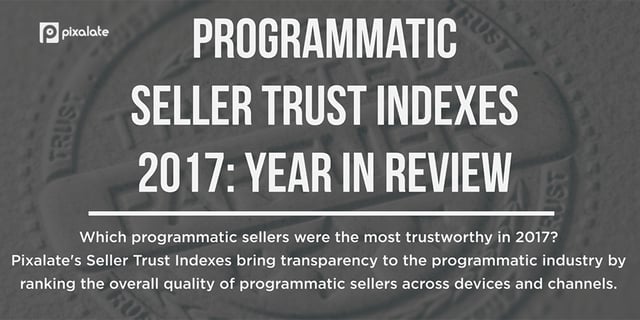
This week's review of ad fraud and quality in the digital advertising space.

Pixalate this week released the 2017 Programmatic Seller Trust Indexes Recap report. The 2017 aggregate rankings are based on the average monthly ranking of every company from each index (GSTI, MSTI, and VSTI). This report shows you which programmatic sellers offered the highest-quality inventory on the most consistent basis. Download the full list of 2017's top-ranked sellers here.

"A study by the World Federation of Advertisers (WFA) has found that the reported average viewability from Media Rating Council (MRC) accredited companies for display is just under 50 per cent, with video averaging 60 per cent, with at least four out of 10 impressions unviewed," wrote Mobile Marketing Magazine. Pixalate's research team contributed to the WFA report.

BuzzFeed News has reported on another online ad fraud scandal. "The malicious code used by Newsweek Media Group websites as part of an ad fraud scheme has been found on sites owned by Christian Media Corporation," wrote BuzzFeed News. "Reporting by BuzzFeed News also found that five CMC websites have been engaging in the same type of ad fraud that was also present on several NMG websites," the article added.

According to a survey conducted by dataxu and the WFA, reported on by eMarketer, only 3% of advertisers have already examined how blockchain can improve transparency and reduce ad fraud. However, 21% plan to make it a major priority in 2018, while 41% plan to make it a minor priority. A further 21% consider it a task for 2019 or beyond. Only 7% say it's not a priority, while another 7% say they aren't yet sure how to prioritize the topic.

According to the latest research from Pixalate, over 66% of the top 5,000 programmatic publishers now have ads.txt implemented. This represents a year-to-date rise of over 42%. Additionally, over 70% of the top 1,000 programmatically-supported sites now have ads.txt. Read the full blog here.
Sign up for our blog to stay updated with new stats, trends, and analysis on digital ad fraud.
*By entering your email address and clicking Subscribe, you are agreeing to our Terms of Use and Privacy Policy.
These Stories on Weekly Recaps
*By entering your email address and clicking Subscribe, you are agreeing to our Terms of Use and Privacy Policy.

Disclaimer: The content of this page reflects Pixalate’s opinions with respect to the factors that Pixalate believes can be useful to the digital media industry. Any proprietary data shared is grounded in Pixalate’s proprietary technology and analytics, which Pixalate is continuously evaluating and updating. Any references to outside sources should not be construed as endorsements. Pixalate’s opinions are just that - opinion, not facts or guarantees.
Per the MRC, “'Fraud' is not intended to represent fraud as defined in various laws, statutes and ordinances or as conventionally used in U.S. Court or other legal proceedings, but rather a custom definition strictly for advertising measurement purposes. Also per the MRC, “‘Invalid Traffic’ is defined generally as traffic that does not meet certain ad serving quality or completeness criteria, or otherwise does not represent legitimate ad traffic that should be included in measurement counts. Among the reasons why ad traffic may be deemed invalid is it is a result of non-human traffic (spiders, bots, etc.), or activity designed to produce fraudulent traffic.”

